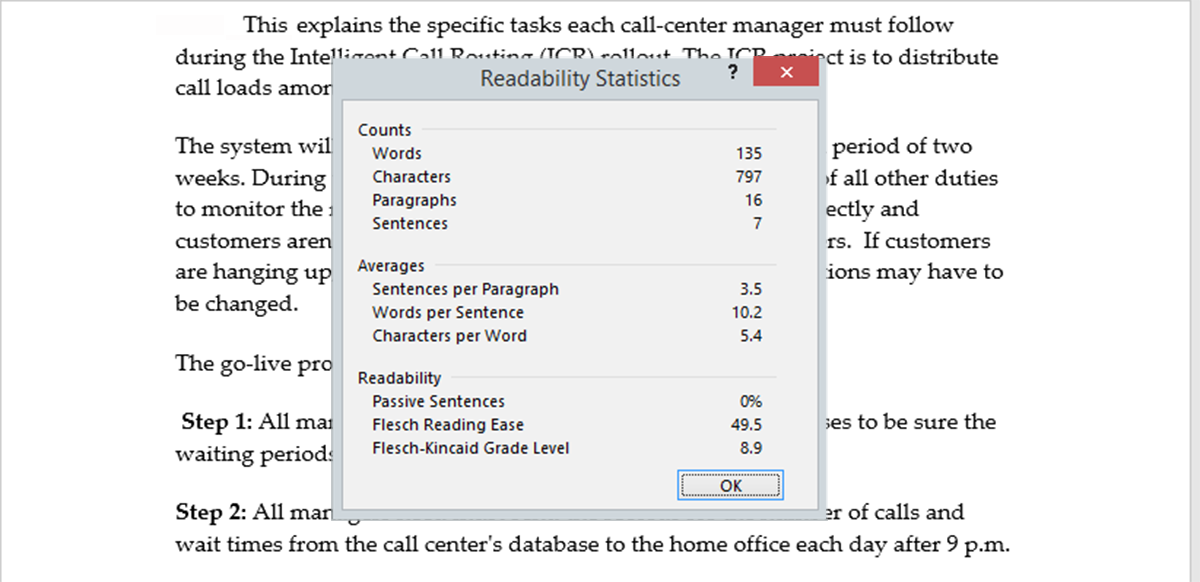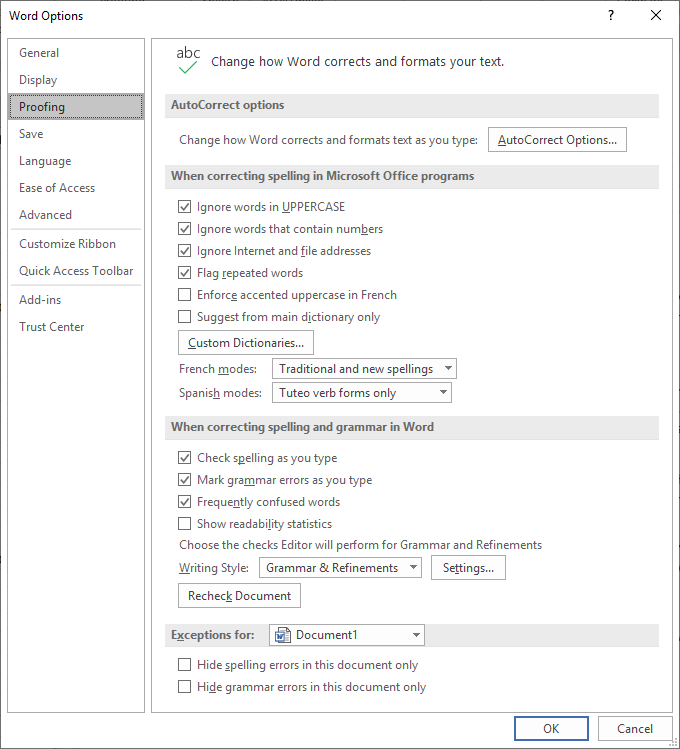
Word's readability score is a great place to start when you want to improve your writing. So let's take a look at what each score means and how you can use them to improve the readability of your work. Here’s some wonderful gobbledygook in a “research paper” (contempt-expressing scare quotes mine) on crisis management, which was recently published by a well-known management consultancy.
Leverage analytics to drive prediction
Use predictive analytics as a decision support tool to drive a forward-looking analysis of scenarios, response effectiveness, and critical correlations that can complicate or escalate events. Better understanding of the drivers of extreme events, whether external developments or internal process interactions, can help build a robust, flexible and dynamic crisis management program. The objective for enhanced analytics is not to predict events, but to help companies develop more meaningful warning indicators, and an increased awareness of their leverage in preventing or managing 'runaway' crises.
And here’s a quick translation of what I think the writer is trying to say (do say in the comments if you think I’ve missed any crucial details).
Learn from the past
If you know what causes crises, you can prepare for them. So analyse what’s happened in the past to help you predict what might happen in the future. It will let you spot the warning signs that a crisis is unfolding, so you can stop it escalating or even happening at all.
I think my version’s more readable. But don’t take my word for it - take a look at each readability score I got from running each piece through the readability tool in Word.
My version
Accessing Readability Statistics in Microsoft Word. Microsoft Word has a built-in function that provides Flesch Reading Ease and Flesch-Kincaid Grade Level scores. The following instructions apply to Word for Office 365, Word 2019, Word 2016, and Word 2013. However, the steps are similar for Word 2010 and 2007. To access readability statistics in Word, you’ll first need to turn the feature on. In Word, click the File tab and then click Options. In the Options window, select the Proofing tab. Enable both the “Check grammar with spelling” and “Show readability statistics” check boxes. Click OK when you’re finished. Microsoft Word’s readability scores are based on American readers. It gives an idea of the quality of writing. Also, It can help improve writing style. The Readability Statistics facility in Microsoft Word includes. If your problem is that Word never displays readability statistics, go into the Word preferences and type 'readability' in the.
If you don’t know about Word’s readability tool, you should. Here’s what you do:
Go to Tools > Spelling and grammar
Under Options, make sure Show readability statistics is selected
When its finished the spell check, Word will give you a rundown of each readability score.

Facts and figures are one thing, but how do you interpret each readability score? Let’s look at the two sets of scores above.
Words
As any writer will tell you, short and sweet is best, and as George Orwell advised, if it’s possible to cut a word out you should. So at 56 words, my text beats the original's readability score (89 words) by some way.
Paragraphs
We were equal on these readability scores, but as a rule of thumb, you should aim for as many paragraphs as you can. Check your morning paper. Notice that most paragraphs are no more than one or two sentences long. That’s because short paragraphs are kinder on the eyes - and therefore easier to read.
Sentences
Again, we scored equally on this occasion. But, as with paragraphs, the higher this figure the better (within your word count). Because if you try to cram too many ideas into one sentence, your writing can become hard to follow.
Remember: full stops are good. They make life easy for your reader.
Words per Sentence
A glance at the two readability scores shows that average sentence written by the original author is 28 words long, compared with my average of 17.3.
I try to stick to a maximum of 24 words a sentence as that’s the point they get hard to read. Some writers are even stricter than me and aim for 20. Use any more than this and it could be a sign you’re trying to cram too many ideas into one sentence.
Characters per Word
This readability score tells me the average word in my text is 4.2 letters long, compared with six in the original.
Like the great orator Winston Churchill, every writer will tell you that short words are best. Given the choice between the polysyllabic indicators and the monosyllabic signs, most writers will choose the latter - as I did. So aim for an average score here of no more than five.
Passive Sentences
We both scored a zero on this readability score, which is a good. In the main, you should be aiming to write in the active voice, not the passive voice, as active sentences are shorter and more dynamic.
If you’re not sure what the difference is, compare the following sentences, which say the same thing in different ways
Passive: The letter was sent by me (6 words)
Active: I sent the letter (4 words)
Flesch Reading Ease
The Flesch Reading Ease and the following readability score, the Flesch-Kincaid Grade Level, take into account all the scores we’ve discussed so far to provide an overall idea of readability.
Surprisingly, we both got pretty good scores here, though I got top marks with 100% readability compared with the original author’s 93.8%.
That the original author achieved an impressive-sounding 93.8% tells you that readability tests are fallible. I suspect most human beings would not read that paragraph and declare it 93.8% readable!
Flesch-Kincaid Grade Level
This score tells you the number of years of education that are needed to understand your text - if you add five to the figure, you get the average reading age that’s required to read it. So what you’re looking for here is a low figure.
I compare favourably with the original author - my text could, apparently, be understood by an eight year old. According to this measure, that same reader would have to reach the age of 12 before she could understand the original author’s text.
Again, I think you’d be hard-pressed to find anyone of any age who would declare the first piece readable. I struggled to follow what the author was trying to say and I have a PhD in English literature - which amounts to a lot more than 7.1 years of education!
What are the overall lessons here?
Readability statistics are a useful but blunt tool. Don’t assume a great score means you’re a great writer.
But do use them as part of your editing process. They can help you compare your before and after versions, or can point you toward ways to improve.
For example, if you get more than 0% on your Passive Sentences readability score, go back and see if you can switch any of those sentences around.
Or if you’ve got more than two or three sentences per paragraph, try and put some white space in your text. You have a thing called a paragraph return key. Use it.
And if your average word is more than five characters long, underline all the long words in your text and think of shorter alternatives.
Finally, don’t underestimate the power of the readability tool as a weapon. If you struggle with verbose executives who think it’s smart to use words like critical correlations or internal process interactions, throw some statistics at them.
I know of one writer who gave his CEO scientific proof that his version of a piece of text was better – simply by pointing out differences in the Flesch-Kincaid Reading Ease figure. The CEO accepted the writer’s edits without question.
Whenever we get to read an article online or any e-book, we tend to skip off some pages if we don’t find the content appealing or incomprehensible. What if users do the same thing happens with our own expertise content? Well, there is no reason to panic, just cool off your heels!
However, there is a small tool out-of–the way which can help you to increase the readability of your content. Microsoft word has a feature that lets you make the quality of your content much better. The Flesch-Kincaid scales readability allows you to shape your document or content into a much better content.
Whatexactly is Flesh –Kincaid Scales Readability?
Flesh –Kincaid scales Readability tests is basically a procedure for testing the level of difficultness to understand a content in english. Here, each readability test has its rating calculated on the average number of syllables per word and words present in each sentence.

How Does It Enhance The Readability Of Your Content?
In Microsoft Word 2013, move to the tab “FILE” .However all these settings may vary according to the version of Microsoft office that you are using. For example, in case of Microsoft word 2007, there is a button known as “Word Options”.
Then select the “options”
The next step consists of select the option “proofing” from the array of options provided. Under the section of “When correcting spelling and grammar in Word”, enable the option “show readability statistics”. This is done in order to enable the enable the Flesch-Kincaid scale. You don’t have to restart the program for putting the changes into effect.
Jcb 803 excavator service manual. Now, word will not be able to evaluate the content’s readability until the option “Spelling and Grammar” is checked. Now you can select‘Spelling and Grammar’s check which is present under the “Review” tab.
When you select the option for ‘Spelling & Grammar’ check, a dialogue box will come up which looks likethe screen given below
You will get to see this screen every time you run a Spelling & Grammar check. After clicking on the “Ok” button, there will be another window which will indicate the readability statistics of your page and here are mine for this content.
Significance of Some Terms Reflected On the Screen
Flesch Reading Ease:
Microsoft Word Readability Checker
Now, finally we have come across the system of Flesh –Kincaid .The essence of whole thing is that the Flesch Reading Ease statistically calculates the readability of your content on a scale that ranges between 0-100. Lower score indicates that the content is more difficult to understand. If the score for your content is 100% then your content is 100% readable and it can be easily understood by everyone.

Microsoft Word Readability
Flesch –Kincaid Grade Level:
It actually tells a person about how many years of education does one need to understand your level of writing. If you want to really know how it is done? Then simply add 5 to the grade number and you will get to know about the average age of a person who can read your content. All this are executed according to the American grade system.
If your Flesch-Kincaid level has a high score level and your Flesch Reading Ease is high then users will discard your page and search for any other page. On the other hand if the Flesh-Kincaid level is very low then users may find it to simple and an inappropriate content. So, you need to balance out both the elements on your page in order to have better readability of your content.

Microsoft Word Readability
Comments are closed.